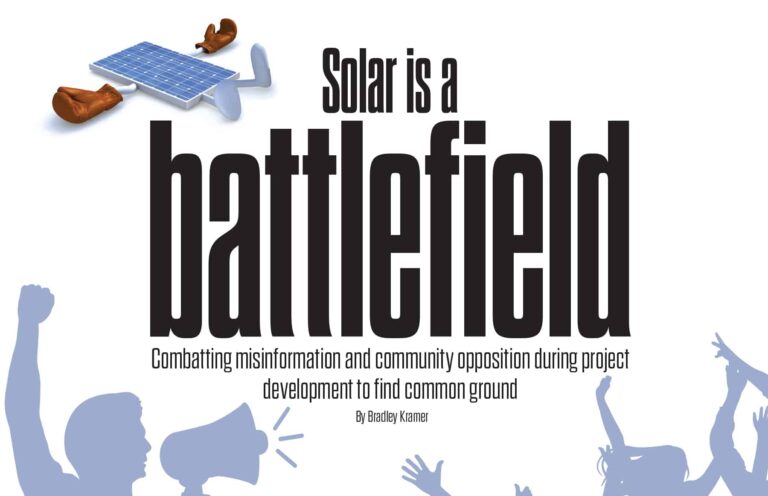A proposed 100 MW solar farm proposed by RWE Clean Energy in Prince George County, Virginia, is drawing opposition from residents who say it will harm their quality of life and threaten the future of local farmers and hunters.
Residents of Moscow, Maine, are voting to ban commercial solar projects, joining a growing list of municipalities across the state that want to limit or ban large solar farms.
An anonymously funded group is spreading misinformation about the 120 MW Frasier Solar project in Knox County, Ohio.
Activists in Klickitat County, Washington, have fiercely opposed solar energy for years, leading two of the county’s three commissioners to approve a temporary ban on new commercial solar projects.
Large-scale solar projects have faced growing opposition from locals calling NIMBY – or Not In My Back Yard. However, there are some best practices that developers can follow to help circumvent these challenges and generate local support for their initiatives.
A big catalyst for solar NIMBYism comes from a lack of understanding about certain projects, according to Gina Brown, senior director of economic development and community engagement at Silicon Ranch.
“We hear different arguments from the opposition, but at the core there is a lot of misinformation,” she says. “It’s about how we can fight the opposition in a timely manner and how we can meet that challenge. There’s a lot of NIMBY-ism in some areas. When we go into different areas, we try to be as transparent as possible about what the project is going to look like, what kind of screening will be used and things like that, and we try to make sure that local residents know that they have a contact person at Silicon Ranch where they can filter questions and get an answer.”
As one of the first 100 employees hired by the Nashville-based developer, owner and operator of solar projects, Brown has seen a lot of growth in the industry, and that has had a direct impact on the growth of the opposition. And the basis of that opposition may depend on where in the United States the project is located. For example, some of the strongest opposition Brown has seen comes from projects in the southeastern U.S., especially when it comes to land use.
“They often worry about what the project will look like and whether solar energy is the best way to use certain lands at this time,” she says. “Solar projects are very specific in where they need to be located. It is important that developers work with the community and explain why this land is the best location for a solar project. That means: the sooner, the better.”
Brown says larger projects draw the most opposition because of the amount of land they require.
“At Silicon Ranch we own our land. A lot of people appreciate that for fear of freaking out,” says Brown. “When they hear that 6,000 hectares are being seized, it is disheartening for some people. It is important for us to say that it is not about 6,000 hectares of solar panels. We believe that we are bringing that country into a period of dormancy. After the project life cycle, we return the land to the same or better condition than how we found it.”
Policy to stimulate solar energy
Echoing Brown’s sentiments about the growth of opposition to the sun, which reflects the growth of solar energy development, Caitlin Connelly, distributed solar research associate at Wooden Mackenziesays more resistance to solar development is found in states where projects are more visible.
“The more saturated states tend to have more vocal opposition,” Connelly says. “The projects are more visible and therefore receive more pushback.”
A lack of trust can be a major factor in the lack of community support.
“It can be difficult for developers to get subscribers for a solar project and build that trust,” Connelly says. “In the Northeast market, where some people don’t trust solar, companies aren’t getting buy-in. Historically, they have had trouble detecting scams, so they don’t trust solar. That’s where you see subscription acquisition companies come in to build trust and reduce the amount of churn that is important for long-term financial success.”
Connelly adds that some of the opposition stems from siting policies and easement acquisition rules that can hinder solar projects. That’s where lobbying efforts can help improve regulations and encourage solar energy development.
“Policy-based solutions can drive more expansion by encouraging brownfield and agrivoltaic energy development,” she says. “Government policy can be developed to encourage companies to build in locations that people wanted developed.”
Brown offers four tips to improve community engagement:
- Understand the community — Researching the location is important. You need to do the legwork before you make the call.
- Contacting — Make sure those living near the project are notified and have a point of contact to talk about the project as early as possible.
- Never too much information – When working with a community, make sure local leaders know what they are approving.
- Be Human – This may be a lofty goal, but meet people where they are and listen to their concerns.
“Nobody wants to feel like they don’t know what’s happening in their own backyard,” Brown says. “If they have a lifeline to talk to, that’s important to them. Send a postcard, follow up and knock on their door. Make a real connection.”
Although Brown adheres to her best practices, she quickly realizes that there is no one-size-fits-all solution for developing solar projects.
“Sometimes I wish projects were more formal, but one thing I like about this job, despite the opposition we face in the industry as a whole, is that no two projects are exactly the same, because you always have different you have to deal with. people.”

Meet them where they are
Getting into a community is a key factor in creating understanding, Brown says, both in terms of the developer’s understanding and locals understanding the project.
“As a business developer, if we find ourselves in a former coal community, we need to understand that they may have a different view of renewable energy that goes way back and takes a different place for them,” Brown says. “Maybe there is a feeling that renewable energy is taking these jobs. We must respect that.”
Instead of having a developer tout the benefits of clean energy, Brown suggests emphasizing the value of the project, the jobs it will create and what it will do for the community.
Another major obstacle for solar developers is the spread of misinformation.
“The amount of disinformation that opponents can channel is due to social media,” says Browns. “We have all seen how the telephone game is played. It doesn’t matter whether it’s about sustainable energy or politics, it’s harder than ever to control the message. That is why it is even more important to explain on site the importance of the project and the reasons behind it.”
Brown goes back to her message about the importance of early communication in the fight against false information.
“There is a misconception that installing solar panels in the ground is dangerous,” says Brown. “There are people who like to benefit from pollution and other environmental consequences. Through our studies they can see that we care for the country. Whether it’s farmland or timberland, we’re going to take care of the land that they respect, and we’re not going to turn it into something that will harm the land in the future.”
Being human
Ultimately, building community support is about trust and communication.
“We need to make sure we lead by example when we set up shop in a community,” Brown says. “We need to let people know the benefit of the solar industry. Just face it, everyone wants to know what’s in it for me.”
One of the most important factors in gaining community support for solar projects may sound simple.
“Be human,” says Brown. “That sounds very general and easy, but it is important to have conversations and meet people where they are. I like the strategy we’re following. We don’t want to go into a community first with the project, but instead let them know who we are and that we want to be a long-term business neighbor, and this is why, this is how and this is when. The sooner you can get in there and meet people at a conversational level, the better you can understand what’s happening in their community and what are the things that matter most to them. That is the best way to create community involvement and collaboration, because ultimately it becomes a partnership.”
Brown’s approach to community engagement is to “dive deeper into really understanding the community” by organizing meetings and making sure that connection is made.
“If we’re just working on structural designs and blueprints, we’re not making connections,” she says.
Brown notes that she did not come into the solar industry with a project development background, but that she has learned an important lesson in the three years she has been involved in the industry: “The work we do in community engagement is not great. science. We are people trying to connect with people.”
Brad Kramer is editor-in-chief of Solar builder.
Listen to more in-depth conversations on Solar Builder’s YouTube channel

Our most popular series include:
Power forward! | A collaboration with BayWa re to discuss industrial topics at a higher level.
The buzz | Where we give our 2 cents per kWh in the residential solar market.
The pitch | Discussions with solar manufacturers about their new technology and ideas.
Source link


